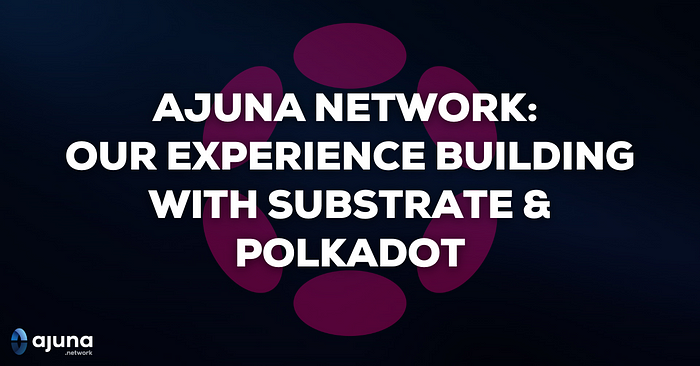Ajuna Network: Our Experience Building With Substrate & Polkadot

Ajuna decided to take up residence on Polkadot after the team’s crowdfunding campaign was successful in securing a Kusama parachain slot. We are excited to announce that this foundation’s vision for Web3 gaming infrastructure has now taken on another dimension thanks to Substrate and Polkadot. But as Polkadot and Substrate are both terms you may not be familiar with, explanations will follow.
The Polkadot ecosystem consists of heterogeneous blockchain fragments referred to as “parachains,” bespoke, project-specific blockchains interconnected with the Polkadot (DOT) and Kusama (KSM) networks. They can be used for a variety of functions, including communication with the primary blockchain, referred to as the relay chain in Polkadot and Kusama.
The Polkadot parachain is a new generation of blockchains, breaking through the limitations of legacy networks. Their ecosystem consists of independent platforms, social networks, and economies that are revolutionizing online communication. And if you have been following Polkadot’s progress, you have probably come across “Substrate” at least once or twice.
Essentially, Substrate serves as a tool for building parachains, while Polkadot serves as a means of safeguarding them and facilitating communication. Although it is a vital part of the Polkadot project, very little information is available about it.
It is easy to convert a Substrate-based chain into a parachain or parathread using Polkadot or Kusama. The two are synergistic, but Polkadot and Substrate do not depend on one another. Polkadot parachains can be created and managed independently of Substrate (although there are currently only a few software options for this), and Substrate chains do not require Polkadot or Kusama connections. As ‘solo chains,’ substrate-based chains can exist separately from one another as well.
But why did Ajuna Network decide to build on Substrate and within Polkadot and not within another ecosystem?
Ajuna’s Prosperous Journey on Polkadot — Why DOT Works
There is not enough room on one blockchain to support a burgeoning future of decentralized applications. In the past, the founder & CEO, Cedric Decoster has used Dash as an infrastructure, but there were limitations that made it difficult to operate smoothly. Due to their relatively low throughput and lack of runtime specialization in early blockchains, they were unsuitable for scaling in many real-world applications.
But with Polkadot’s proprietary heterogeneous sharding system, chains can be tailored to suit specific requirements as opposed to being limited to a generic approach. It is because of this flexibility that networks can run publicly or privately and have their own native token, as well as their own governance system.
Additionally, Polkadot provides interoperability through the construction of relay chains and parachains. Two main purposes are served by the relay chain:
- Maintain a high level of network security
- Ensure seamless chain interoperability
Polkadot also revolutionizes the process of upgrading blockchains, thus enabling them to upgrade themselves without forking. These forkless upgrades are made possible by Polkadot’s decentralized on-chain governance model, which allows projects to remain flexible, nimble, and responsive to emerging technologies.
Last but not least, parachains are automatically secured when they are connected to Polkadot. You may be aware of how blockchains are typically required to establish security by setting up a network of validators and processors, an extremely complex and lengthy procedure that leaves blockchains vulnerable to attacks.
DOT’s integrated security solution, also known as shared security, offers new blockchain projects enhanced security without requiring them to exert much effort. Due to Polkadot’s nominated proof-of-stake architecture (a system in which validators can validate transactions on behalf of users and receive credit for their work), all projects in the ecosystem are essentially protected by DOTs in a shared security system.
Additionally, it reduces the barriers to entry as well as the time it takes to launch new networks. Although, Ajuna has not found working with Polkadot easy from the outset. The team’s experience with this blockchain can perhaps be summed up in two words: Interesting yet complicated.
Currently, Ajuna works with amazing networks like Integritee and Darwinia and has an eye on fascinating Polkadot projects like XCM V3, Remark, and Moonbeam. Each of these projects contributes to the environment multi-chain approach in a highly specialized and valuable way.
The Future of Polkadot & Debuts Like Ajun
New crypto projects emerge almost every day in the crypto industry. There are only a few who break through and manage to stay at the top, and Polkadot has done just that.
The Polkadot Web3 Foundation’s vision for the future involves supporting projects aligned with its mission by providing financial support or other assistance like:
- Protocols for cryptographic messaging and innovative blockchain technologies.
- Infrastructure for peer-to-peer networks (for example, libp2p and devp2p)
- Mechanisms for crypto-economics (like DAC/DAOsoftware)
- Systems for storing and publishing data (e.g. IPFS).
Ajun is a utility token that will be needed by both creators and players on the Ajuna Network in order to launch games, participate in competitions, pay fees, vote, and more. Check out the details here and subscribe to the Ajuna newsletter to stay updated on Ajuna tokens.
